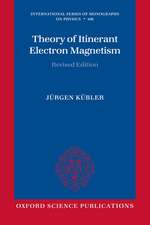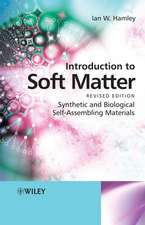Group Theory: Application to the Physics of Condensed Matter
Autor Mildred S. Dresselhaus, Gene Dresselhaus, Ado Jorioen Limba Engleză Hardback – 13 dec 2007
| Toate formatele și edițiile | Preț | Express |
|---|---|---|
| Paperback (1) | 364.01 lei 22-36 zile | +41.71 lei 6-12 zile |
| Springer Berlin, Heidelberg – 14 oct 2010 | 364.01 lei 22-36 zile | +41.71 lei 6-12 zile |
| Hardback (1) | 460.47 lei 17-23 zile | +41.32 lei 6-12 zile |
| Springer Berlin, Heidelberg – 13 dec 2007 | 460.47 lei 17-23 zile | +41.32 lei 6-12 zile |
Preț: 460.47 lei
Preț vechi: 568.48 lei
-19% Nou
Puncte Express: 691
Preț estimativ în valută:
88.11€ • 92.23$ • 73.34£
88.11€ • 92.23$ • 73.34£
Carte disponibilă
Livrare economică 05-11 martie
Livrare express 22-28 februarie pentru 51.31 lei
Preluare comenzi: 021 569.72.76
Specificații
ISBN-13: 9783540328971
ISBN-10: 3540328971
Pagini: 598
Ilustrații: XV, 582 p.
Dimensiuni: 155 x 235 x 38 mm
Greutate: 0.95 kg
Ediția:2008
Editura: Springer Berlin, Heidelberg
Colecția Springer
Locul publicării:Berlin, Heidelberg, Germany
ISBN-10: 3540328971
Pagini: 598
Ilustrații: XV, 582 p.
Dimensiuni: 155 x 235 x 38 mm
Greutate: 0.95 kg
Ediția:2008
Editura: Springer Berlin, Heidelberg
Colecția Springer
Locul publicării:Berlin, Heidelberg, Germany
Public țintă
GraduateCuprins
Basic Mathematics.- Basic Mathematical Background: Introduction.- Representation Theory and Basic Theorems.- Character of a Representation.- Basis Functions.- Introductory Application to Quantum Systems.- Splitting of Atomic Orbitals in a Crystal Potential.- Application to Selection Rules and Direct Products.- Molecular Systems.- Electronic States of Molecules and Directed Valence.- Molecular Vibrations, Infrared, and Raman Activity.- Application to Periodic Lattices.- Space Groups in Real Space.- Space Groups in Reciprocal Space and Representations.- Electron and Phonon Dispersion Relation.- Applications to Lattice Vibrations.- Electronic Energy Levels in a Cubic Crystals.- Energy Band Models Based on Symmetry.- Spin–Orbit Interaction in Solids and Double Groups.- Application of Double Groups to Energy Bands with Spin.- Other Symmetries.- Time Reversal Symmetry.- Permutation Groups and Many-Electron States.- Symmetry Properties of Tensors.
Recenzii
From the reviews:
"It was developed for a graduate course taught mostly by Millie Dresselhaus at MIT for more than 30 years, with many revisions of lecture notes. Very much a graduate text or specialist monograph, the book covers a wealth of applications across solid-state physics. … The book can be warmly recommended to students and researchers in solid-state physics, either to serve as a text for an advanced lecture course or for individual study … ." (Volker Heine, Physics Today, November, 2008)
"This textbook is based on the authors’ pedagogical experience during their 30 years at MIT. … the book develops all of the relevant mathematics (linear algebra) and the necessary physics (quantum mechanics), it is eminently suitable to a wide audience in physics, chemistry and materials science." (Barry R. Masters, Optics and Photonics News, July/August, 2009)
“This is an excellent text … . originates from lectures by Charles Kittel and J. H. van Vleck in the 1950s and much of the material was presented in courses by the authors over the last three decades. The material is meant for Electrical Engineering and Physics students at the graduate level … . has exercises at the end of each chapter and an extensive set of appendices. The exposition is clear and detailed. This is a very good book for its target audience.” (W. Miller Jr., Zentralblatt MATH, Vol. 1175, 2010)
“The goal of the book under review is to teach group theory in close connection to applications. … Every chapter of the book finishes with several selected problems. Specific to this book is the feature that every abstract theoretical group concept is introduced and applied in a concrete physical way. This is why the book is very useful for anyone interested in applications of group theory to the wide range of condensed matter phenomena.” (Oktay K. Pashaev, Mathematical Reviews, Issue 2010 i)
“It is highly welcomed because of its well-thought structuring and the plenty ofnon-trivial examples. The authors develop those parts of the theory of groups which are interesting for physicists, from chapter to chapter offering nearly at any step one or more informative application.” (G. Kowol, Monatshefte für Mathematik, Vol. 157 (2), June, 2009)
"It was developed for a graduate course taught mostly by Millie Dresselhaus at MIT for more than 30 years, with many revisions of lecture notes. Very much a graduate text or specialist monograph, the book covers a wealth of applications across solid-state physics. … The book can be warmly recommended to students and researchers in solid-state physics, either to serve as a text for an advanced lecture course or for individual study … ." (Volker Heine, Physics Today, November, 2008)
"This textbook is based on the authors’ pedagogical experience during their 30 years at MIT. … the book develops all of the relevant mathematics (linear algebra) and the necessary physics (quantum mechanics), it is eminently suitable to a wide audience in physics, chemistry and materials science." (Barry R. Masters, Optics and Photonics News, July/August, 2009)
“This is an excellent text … . originates from lectures by Charles Kittel and J. H. van Vleck in the 1950s and much of the material was presented in courses by the authors over the last three decades. The material is meant for Electrical Engineering and Physics students at the graduate level … . has exercises at the end of each chapter and an extensive set of appendices. The exposition is clear and detailed. This is a very good book for its target audience.” (W. Miller Jr., Zentralblatt MATH, Vol. 1175, 2010)
“The goal of the book under review is to teach group theory in close connection to applications. … Every chapter of the book finishes with several selected problems. Specific to this book is the feature that every abstract theoretical group concept is introduced and applied in a concrete physical way. This is why the book is very useful for anyone interested in applications of group theory to the wide range of condensed matter phenomena.” (Oktay K. Pashaev, Mathematical Reviews, Issue 2010 i)
“It is highly welcomed because of its well-thought structuring and the plenty ofnon-trivial examples. The authors develop those parts of the theory of groups which are interesting for physicists, from chapter to chapter offering nearly at any step one or more informative application.” (G. Kowol, Monatshefte für Mathematik, Vol. 157 (2), June, 2009)
Notă biografică
M. S. Dresselhaus received her Ph.D. in Physics from the University of Chicago, in 1958. An Institute Professor at the Massachusetts Institute of Technology, she has been active in many aspects of materials research with particular emphasis on carbon science including nanostructures such as carbon nanotubes, but also including bismuth nanowires and other materials systems relevant to low dimensional thermoelectricity. She is the recipient of the National Medal of Science and 21 honorary degrees worldwide. She served as the Director of the Office of Science at the DOE in 2000--2001 and co-chaired a DOE report "Basic Research Needs for the Hydrogen Economy (2003).
G. Dresselhaus received his Ph.D. in Physics from the University of California, Berkeley, CA in 1955. He was a faculty member at the University of Chicago, and assistant professor at Cornell before joining MIT Lincoln Laboratory in 1960 as a staff member. In 1976 he assumed his current senior staff position at the MITFrancis Bitter Magnet Laboratory. His area of interest is the electronic structure of nanomaterials and he has co-authored with M.S. Dresselhaus several books on fullerenes, nanowires, and nanotubes.
A. Jorio received his Ph.D in Physics from the Universidade Federal de Minas Gerais (UFMG), Belo Horizonte, Brazil, in 1999. He worked with Phase Transitions on Incommensurate Crystals, and he spent one year at the Institute Laue-Langevin (ILL), Grenoble, France. He also spent two years (2000 and 2001) as a post-doc at the Massachusetts Institute of Technology (MIT), Cambridge, USA, working with Raman Spectroscopy of Carbon Nanotubes. In 2001 he received the PROFIX Fellowship from the Brazilian Science Foundation CNPq, and returned to Brazil. He is a Professor of Physics at UFMG since 2002. Jorio's research interests focus on resonance Raman spectroscopy techniques and the photophysics of nanostructures.
G. Dresselhaus received his Ph.D. in Physics from the University of California, Berkeley, CA in 1955. He was a faculty member at the University of Chicago, and assistant professor at Cornell before joining MIT Lincoln Laboratory in 1960 as a staff member. In 1976 he assumed his current senior staff position at the MITFrancis Bitter Magnet Laboratory. His area of interest is the electronic structure of nanomaterials and he has co-authored with M.S. Dresselhaus several books on fullerenes, nanowires, and nanotubes.
A. Jorio received his Ph.D in Physics from the Universidade Federal de Minas Gerais (UFMG), Belo Horizonte, Brazil, in 1999. He worked with Phase Transitions on Incommensurate Crystals, and he spent one year at the Institute Laue-Langevin (ILL), Grenoble, France. He also spent two years (2000 and 2001) as a post-doc at the Massachusetts Institute of Technology (MIT), Cambridge, USA, working with Raman Spectroscopy of Carbon Nanotubes. In 2001 he received the PROFIX Fellowship from the Brazilian Science Foundation CNPq, and returned to Brazil. He is a Professor of Physics at UFMG since 2002. Jorio's research interests focus on resonance Raman spectroscopy techniques and the photophysics of nanostructures.
Textul de pe ultima copertă
Every process in physics is governed by selection rules that are the consequence of symmetry requirements. The beauty and strength of group theory resides in the transformation of many complex symmetry operations into a very simple linear algebra. This concise and class-tested book has been pedagogically tailored over 30 years MIT and 2 years at the University Federal of Minas Gerais (UFMG) in Brazil. The approach centers on the conviction that teaching group theory in close connection with applications helps students to learn, understand and use it for their own needs. For this reason, the theoretical background is confined to the first 4 introductory chapters (6-8 classroom hours). From there, each chapter develops new theory while introducing applications so that the students can best retain new concepts, build on concepts learned the previous week, and see interrelations between topics as presented. Essential problem sets between the chapters also aid the retention of the new material and for the consolidation of material learned in previous chapters. The text and problem sets have proved a useful springboard for the application of the basic material presented here to topics in semiconductor physics, and the physics of carbon-based nanostructures.
Caracteristici
Unique pedagogical textbook by the gifted Professor Mildred Dresselhaus Includes supplementary material: sn.pub/extras


















